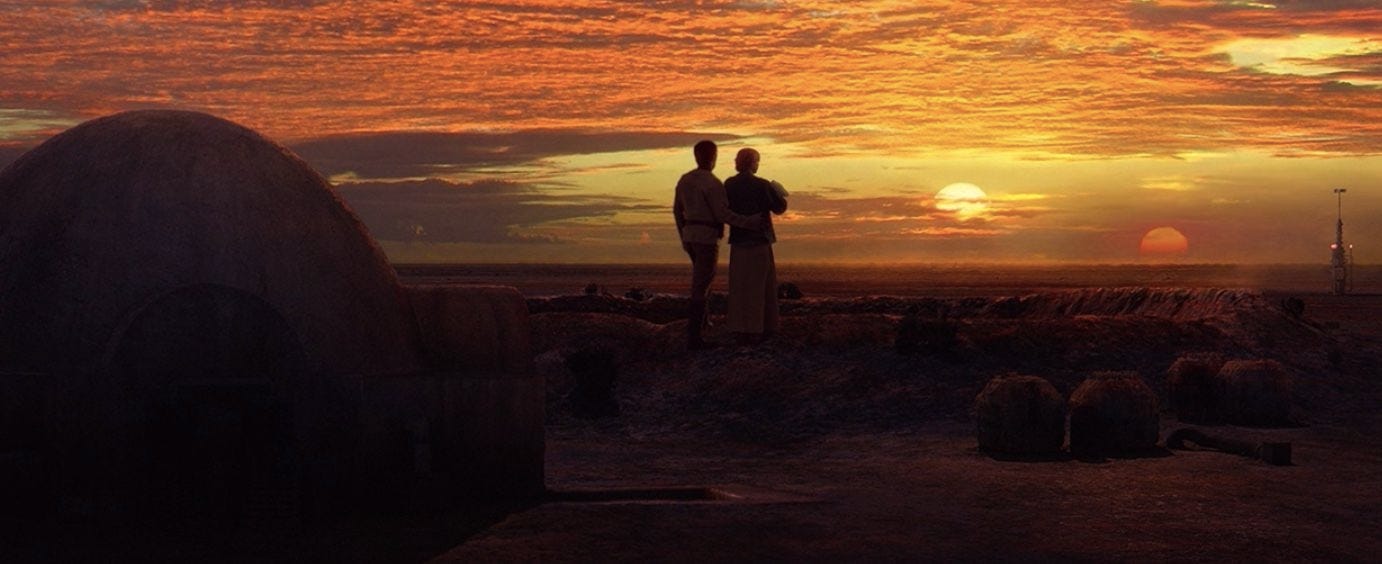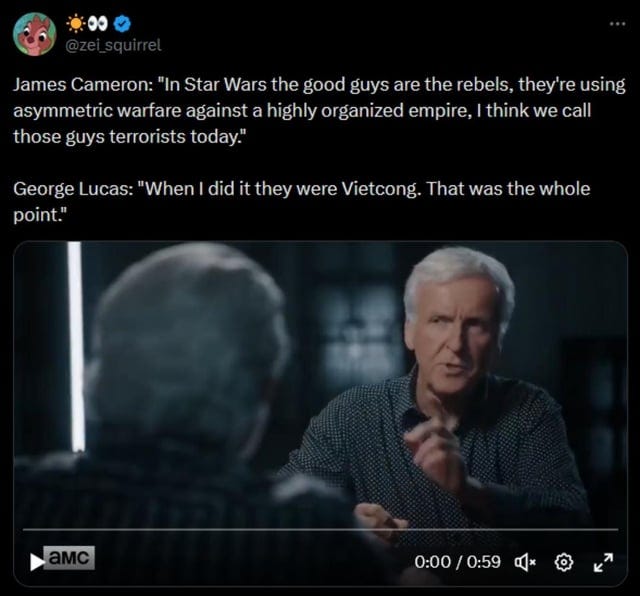Star Wars Episode III: Revenge Of The Sith
I saw this film like it was a full time job (This one is a long read)
I’ve seen this movie countless times. When it first premiered in 2005 I accidentally watched it five days in a row. One might ask how does one accidentally watch something, let alone five days in a row?
Day 1. The premiere. Midnight, costumes, the excitement of seeing a new Star Wars film with the sadness due to the fact that it was going to be considered to be the final Star Wars film. I was literally on the edge of my seat the whole time.
Day 2. My friend Zach couldn’t make it to the premiere so we saw it the following day.
Day 3. My friend Joe hadn’t made it to the two previous times so I went with him.
Day 4. I got bored and said “Hey, isn’t there a Star War playing? I’ll watch that!”
Day 5. My father had missed it and we went to it as a family.
The experience I had watching this film for the 20th (saints preserve us) anniversary was unlike any of the other times I’ve seen it. For context, I saw it in an Events Cinema here in Auckland, New Zealand. New Zealand famously is not America (we should all be so lucky) and in New Zealand they tend towards politeness in most things. This is all to say, the showing was dead quiet. When I saw Phantom Menace in theaters last year there were cheer and applause breaks for characters introductions, often started by myself. Whereas here no characters were greeted with whoops or hollers, but with the quiet solemnity that might beget passing someone you know who is on the way to the bathroom so you don’t say anything but simply nod.
Still all and all a great time.
Okay, so this movie.
This movie has a lot to say about the decline of democracy and the rise of fascist regimes. This is all I say on the matter other than WHEW BOY.
For those who aren’t aware I will try to summarize succinctly the events that transpire in Revenge Of The Sith.
War! The galaxy far, far away is at it. Two Jedi Knights are dispatched to rescue the chancellor of The Republic, a man named Palpatine who suffers from chronic Camp Disease, from the grips of The Confederacy Of Independent Systems. During which time Anakin Skywalker, a young and powerful Jedi with Complex PTSD, eliminates the leader of the CIS Count Dooku, who does a sick flip when he’s introduced. Obi-Wan Kenobi, Anakin’s former teacher with a Japanese coded name despite being perhaps the whitest person you can imagine, is also there.
Due to the ongoing conflict both the offices of the chancellor and the Jedi council at each other’s throats and chose to use Anakin, a young soon to be father by the way, to spy on each other. Anakin is understandably, STRESSED OUT.
His wife, Padmé is with child and also a senator which is also a stressful job!! Both of the are STRESSED, but despite being both pregnant and a politician representing a whole ass planet, Padmé is so concerned about Anakin.
Also, Anakin is having nightmares that Padmé will die in childbirth. The dreams have happened before right before his mother died. Concerned, Anakin turns to his mentor and father figure, the king of Camp himself, Chancellor Palpatine for guidance.
It turns out Palpatine is a Sith Lord, one of the most evil men in the universe, (and he’s a politician you say??) But, Palpatine tells Anakin he can show him a power that could save Padmé’s life. Anakin agrees and betrays his friends, family, and ideals for love.
It does not go well.
He ends up dismembered and lit on fire after fighting Obi-Wan in what can be only described as the sickest laser sword fight on screen.
No one is happy. Padmé has died. The End.
Okay, so this movie.
I’ll be writing another essay about Anakin and how his actions make sense if you take into consideration his background and the fact that the man is clearly unwell and is not getting the support he needs from his community. Also, he’s greedy and like 23. Do you remember what you were like at that age? So, I’m not going to get into all that right now, but it is there both subtextually and textually.
Anakin as a character means a great deal to me and I find this whole movie just incredibly sad. (Good Job George!!)
This film is also about America, if you can believe it. The use of War and the select targeting and elimination of a quasi-religious group of minorities can’t help but feel, shall we say, relevant. I must needs remind you as well that this is the twentieth anniversary of this film. The use of “Us v. Them” (whomever they are) rhetoric is sadly all too familiar. As is the corruption of trading concerns, who joined extremist groups after facing *checks notes* TRADE TARIFS. I’m not saying anything new here. Which makes it all the more frustrating.
This film is beautiful. One of the things that bothers me the most regarding to the general reception of The Star Wars Prequels is the fact that people think the films are ugly. They won’t say it like that. They’ll say, “Too much CGI,” or “You can tell they’re all on blue screen,” or the dreaded, “I prefer practical effects.” All of these things are fine to say, but at the heart of the matter is the fact that you think it’s an ugly movie. Which, to people’s credit, film as a medium is visual. If you think a movie is ugly, an actor unappealing, or the camera work shoddy it is in fact, incredibly hard to watch said film.
My case is this: Revenge Of The Sith is a fantasy melodrama, its grandeur is to a scope impossible to construct on planet earth. The exceptionally talented folks at Industrial Light and Magic went above and beyond, pioneering new technology to create worlds unlike we’ve seen before in cinema. The people who worked on these films were dedicated, creative, and deeply thoughtful in their pursuit of grand art that stands the test of time. I think they’re done an incredible job and should be commended. The digital matte paintings of Coruscant, Mustafar, and Tatooine are favorites of mine.
Just because someone is painting with a computer doesn’t mean it isn’t art.
Here’s a documentary about digital art from ILM if you’re curious:
Also, it’s wild the George uses a digital split diopter effect (when both subjects are in focus in a frame) in this shot to show that both Anakin and Obi-Wan are at fault.
The grandeur of Sith isn’t just in its scope of design but in its heart. At its core the film is about betrayal and brotherhood, love and jealousy, influence and corruption. All themes that are classical in form.
Found in Revenge Of The Sith are the conflicts of literature.
Man V. Nature: Palpatine’s perversion of The Force through “unnatural” means.
Man V. Man: They fight.
Man V. God: Anakin’s desire to control The Force.
Man V. Society: The destruction of The Republic and the rise of The Empire.
Man V. Self: Anakin’s internal conflict found throughout the film.
Man V. No God: Anakin’s religion has failed him and he knows not what to believe.
Man V. Technology: They’re literally fighting robots.
Man V. Reality: Anakin’s view point is not based in truth, but in stress and deception.
Man V. Author: This film is straining at every frame to be more than it is. George Lucas’ vision is at war with the film he made.
Also, Anakin is trapped forever in a robot suit thus fighting himself, nature, and technology.
Here’s critic and academic Camille Paglia talking about the grandeur and beauty of Revenge Of The Sith:
All and all I would say this movie is my least favorite out of the six films George Lucas made, but is still a great watch with a lot going on. Perhaps, some might say, too much.
I do love this movie even though it makes me just so, so sad.
RIP Padmé and The Republic.
The Runtime is 140 minutes.










Just reading this made me sad. 🥺 Good article though!